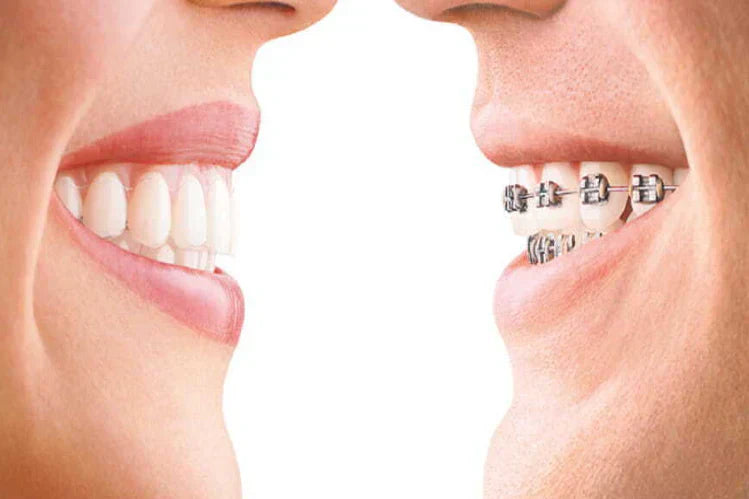
The right orthodontic treatment can be a game-changer for your smile. When it comes to straightening teeth, the debate often boils down to teeth aligners vs. traditional braces, each with advantages and drawbacks. Teeth aligners, a popular removable orthodontic device, are another option for discreet and flexible treatment, unlike fixed or removable braces. But how do they compare comfort, effectiveness, and convenience?
Whether you are an adult considering aligners vs braces for adults or wanting to explore teeth aligners benefits and drawbacks, knowing the differences is important. It gives you everything you need to know, including treatment time with aligners vs braces, maintenance, cost, dietary guidelines about what to eat with braces , and more. Let’s explore!
What are Teeth Aligners?

Teeth aligners are transparent, removable trays that gradually shift teeth into alignment. Made from medical-grade plastic, they are custom-made for each patient. Popular brands like ALIGNERCO have made removable orthodontic devices a preferred choice for adults and teens.
Pros of Teeth Aligners
Appearance
Aligners are practically invisible compared to braces since they are custom-made to fit your teeth. Hence, this may be a consideration for many, but not all patients.
Diet
Since you can easily remove the aligners to eat, your diet will not be affected during the treatment. You will be able to enjoy all the food you want!
Hygiene
As aligners are removable, you can brush and floss normally, ensuring better oral hygiene throughout the treatment.
Appointments
Since tooth movement is pre-planned, visits to the orthodontist are often much simpler. In most cases, aligner treatments require fewer in-person appointments than traditional braces. This can be a big advantage for all those who are living busy lives!
Comfort
Teeth aligners are generally more comfortable as they don't disturb the oral cavity like conventional braces. Although the teeth can still be somewhat tender as they begin to move, the lips and cheeks tend to be less irritated as the plastic aligner is smoother than the steel or porcelain braces.
Cons of Teeth Aligners
The following are the cons of teeth aligners:
Compliance
The patient must observe 22 hours of aligner use daily; wear-time is only to be interrupted for eating and cleaning. Compliance equals success!
Aligner Removal
Since aligners need to be removed before eating, some self-conscious individuals may feel uneasy when dining out. Some patients might feel quite embarrassed or shy about this in public.
Effectiveness
Aligners are a great solution for mild to moderate cases, and, under the supervision of a trained orthodontist, can even handle some complex issues.
Oral Hygiene
Proper oral hygiene is essential. If not maintained, aligners can trap bacteria against your teeth, causing plaque buildup and bad breath. So always brush your teeth and clean your aligners to maintain a healthy smile.
What are Traditional Braces?

Traditional braces consist of metal brackets bonded to teeth, connected by wires and elastic bands. They are fixed braces, meaning they stay in the mouth until an orthodontist removes them.
How Do Traditional Braces Work?
- Brackets are glued to the teeth along with an archwire that applies pressure.
- Adjustments tighten the wire every 4-6 weeks..
- Depending on the severity of the misalignment being corrected, treatment can take anywhere from 18 to 36 months.
Pros of Traditional Braces
Types of Braces
Braces come in several types, including metal, colorless, and colored options. Porcelain braces are also available and are much more discreet than standard metal braces.
Compliance
As the braces are attached to your teeth, you cannot forget to wear them or lose them. This can be useful for some patients if they are not internally motivated to comply with wearing aligners adequately.
Cons of Traditional Braces
Hygiene
It is challenging to clean your teeth with braces rather than aligners. If cleaning is not done adequately, damage can occur to the teeth.
Diet
With braces on your teeth, you’ll need to adjust your diet. Hard foods or nighttime grinding can cause breakages, which may delay or halt your treatment. If you’re wondering, “ Can you chew gum with your braces ?” The answer is no! Braces increase your susceptibility to tooth decay, so it's crucial to avoid sugary and sticky foods. A poor diet combined with inadequate hygiene can lead to serious complications.
Comfort
Generally speaking, braces are more likely to cause discomfort as they can rub on the cheeks and lips. Some patients suffer from this more than others, and it is often a matter of concern for people involved in some sports and other activities.
Appearance
Braces (even the porcelain ones) are more noticeable than aligners. This is important for some patients depending on their occupation, hobbies, and personality.
Appointments
Braces typically require longer and more involved appointments, as active adjustments must be made during each visit. Additionally, you may need to schedule more frequent visits for adjustments.
Key Differences: Teeth Aligners vs. Traditional Braces
| Features | Braces | Teeth Aligners |
| Appearance | Highly visible | Nearly invisible |
| Removability | It can’t be removed until treatment is over | Removable at any time |
| Comfort | May cause mouth irritation | Less likely to cause mouth irritation |
| Material | Metal and rubber bands | Medical-grade plastic |
| Hygiene | Require frequent brushing and flossing during the day | Can be removed for oral hygiene routine |
| Compliance | Not dependent on daily compliance | Highly dependent on daily compliance |
| Diet Restrictions | Avoid carbonated drinks, and hard, crunchy, chewy, or sticky foods. | No dietary restrictions, simply remove them before eating or drinking |
| Treatment Duration | Around 24 months | 4-6 months |
| Cost | Expensive | Affordable |
| Best for | All sorts of complex cases | For those who want a discreet treatment |
Aligners vs. Braces for Adults: Which Is Better?
When choosing between aligners and braces as an adult, it’s important to consider factors like appearance, comfort, and the complexity of your dental needs. Aligners are discreet, removable, and comfortable, making them ideal for those with mild to moderate issues and who prioritize aesthetics. However, traditional braces are more effective for severe misalignment and complex dental problems, offering faster results for challenging cases. Ultimately, the best choice depends on your specific orthodontic needs and lifestyle, so consulting with an orthodontist is key to making an informed decision.
Introducing ALIGNERCO Clear Aligners

By using ALIGNERCO Clear Aligners, you can discreetly achieve a beautifully aligned smile at an affordable price—all from the comfort of your home. Their customized, removable aligners gradually shift teeth into their ideal positions without the need for metal wires or brackets. Since ALIGNERCO's treatment is remote, it’s ideal for mild to moderate cases of misalignment, offering a convenient solution for adult and teenage patients. Please note, for more complex cases, in-person orthodontic care may be necessary.
Why Choose ALIGNERCO Clear Aligners?
- Nearly Invisible: Clear aligners are generally so invisible that they become part of your natural smile.
- Removable Design: It allows you to eat and drink, and brush your teeth freely without limitations.
- Custom Treatable Plan: Digital scans ensure that tooth alignment will be precise.
- Affordable Pricing: ALIGNERCO Clear aligners offer a budget-friendly option, which makes them more economical than conventional braces.
- Faster Results: Mild dental cases may show improvement within 6 to 12 months.
Finding Your Perfect Fit
Teeth aligners are effective for mild cases, offering a discreet and convenient teeth straightening solution. Traditional braces require food restrictions and frequent dental visits. Teeth aligners are clear, removable, and comfortable, and suitable for those with mildly to moderately misaligned teeth. However, when the orthodontist identifies a significant issue, traditional braces are superior due to their higher accuracy.
For those who do not want anything complicated, practical, and barely noticeable, ALIGNERCO Clear Aligners are a perfect choice.
FAQs
1. Are traditional braces better than aligners?
Fixed braces are more appropriate with complex cases of misalignment since clear aligners are better suited for mild to moderate cases. Depending on your situation, your orthodontist can decide which is more suitable for you
2. What are the disadvantages of aligners?
They have to be worn for a suitable number of hours per day, which is 20 to 22 hours, and cannot resolve severe alignment problems. They also need removal for eating and drinking of foods and beverages that can interfere with their ability to practice good hygiene.
3. Which works faster, aligners or braces?
For minor adjustments, ALIGNERCO clear aligners can work faster: 4 to 6 months. For severe cases, braces may be used for 18-36 months.
4. Do aligners change face shape?
Clear aligners are designed for teeth straightening, but in some cases, they may also improve jaw alignment, enhancing facial symmetry.
5. What to eat with braces in the first week?
Choose soft foods like yogurt, soup, mashed potatoes, and smoothies. Avoid hard, crunchy, or sticky foods. Cut food into small bites and chew gently. Drink plenty of water.
Citations:
American Association of Orthodontists. (2023). Braces vs. clear aligners: What's the difference? https://www.aaoinfo.org
Nguyen, T., Jackson, T., & Patel, R. (2020). Effectiveness of clear aligners versus traditional braces: A systematic review. Journal of Orthodontic Research, 28(3), 112–118. https://doi.org/10.1016/j.jor.2020.03.006
Rossini, G., Parrini, S., Castroflorio, T., Deregibus, A., & Debernardi, C. L. (2015). Efficacy of clear aligners in controlling orthodontic tooth movement: A systematic review. The Angle Orthodontist, 85(5), 881–889. https://doi.org/10.2319/061614-436.1
Ke, Y., Zhu, Y., & Zhu, M. (2019). A comparison of treatment effectiveness between clear aligner and fixed appliance therapy. BMC Oral Health, 19(1), 24. https://doi.org/10.1186/s12903-019-0710-8
Papadimitriou, A., Mousoulea, S., Gkantidis, N., & Kloukos, D. (2018). Clinical effectiveness of Invisalign® orthodontic treatment: A systematic review. Progress in Orthodontics, 19(1), 37. https://doi.org/10.1186/s40510-018-0235-6
Djeu, G., Shelton, C., & Maganzini, A. (2005). Outcome assessment of Invisalign and traditional orthodontic treatment compared with the American Board of Orthodontics objective grading system. American Journal of Orthodontics and Dentofacial Orthopedics, 128(3), 292–298. https://doi.org/10.1016/j.ajodo.2005.06.002
Weir, T. (2017). Clear aligners in orthodontic treatment. Australian Dental Journal, 62(1), 58–62. https://doi.org/10.1111/adj.12480





